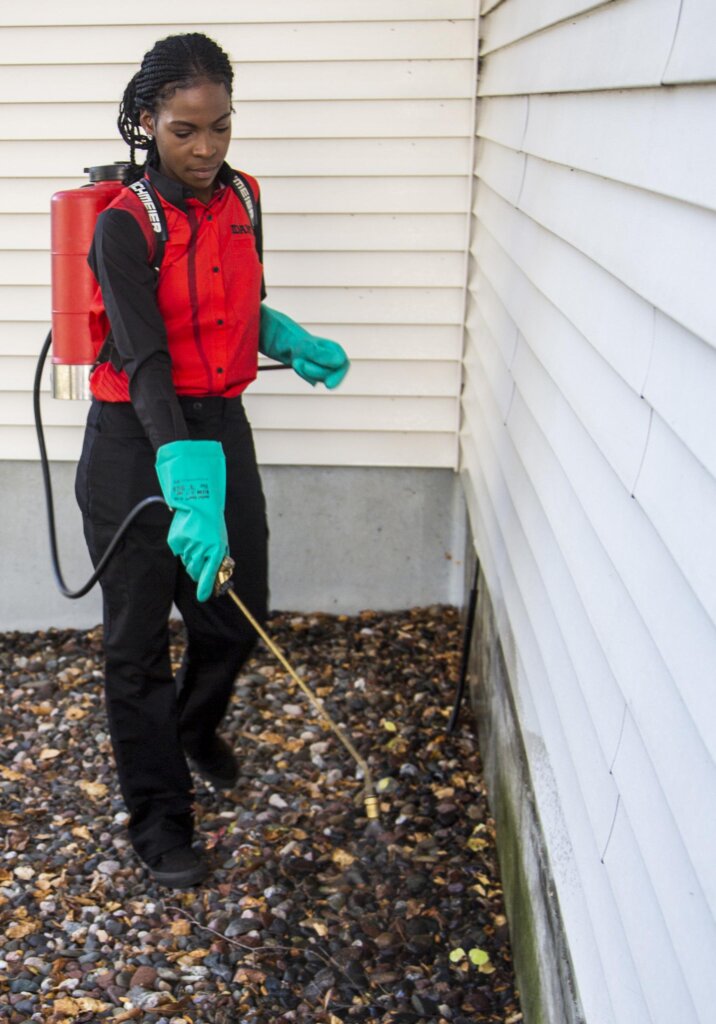Quality A1 Pest Control Services Charlotte - Protect Your Home
Quality A1 Pest Control Services Charlotte - Protect Your Home
Blog Article
Bed Insect Therapy Malfunction: Comparing Chemical Vs. Non-Chemical Solutions
In the realm of bug control, specifically when managing the relentless problem of bed insects, the option in between chemical and non-chemical treatment services can be a pivotal one. Both approaches supply unique benefits and drawbacks, affecting factors such as effectiveness, safety and security considerations, and total expense. By examining the nuanced information of each technique, a clearer understanding of which path to go after in addressing a bed insect problem can be obtained.
Performance of Chemical Treatments
Chemical treatments for bed pest problems have actually been widely identified for their rapid and potent effectiveness in eradicating these parasites. When taking into consideration the efficiency of chemical therapies, it is vital to recognize that they can give a fast and comprehensive solution to a bed bug trouble. Professional exterminators typically rely on pesticides to target bed pests at various phases of their life cycle, including eggs, grownups, and nymphs. These chemicals commonly work by interfering with the bed insects' nervous system, resulting in paralysis and ultimate death.
In addition, chemical treatments have the advantage of offering residual impacts, suggesting that they can remain to eliminate bed insects also after the first application. This recurring action is especially advantageous in combating any kind of prospective re-infestations. In addition, the fast action of chemical therapies can bring relief to individuals facing serious bed insect invasions, allowing them to gain back control of their home promptly.
Safety Interest In Chemical Solutions
One essential aspect that requires cautious factor to consider when making use of chemical options for bed bug treatment is making certain the safety and security of occupants and the setting. Direct exposure to specific chemicals made use of in bed bug therapies can lead to respiratory problems, skin irritation, or various other unfavorable reactions, especially in people with pre-existing conditions or level of sensitivities.
Furthermore, the ecological influence of chemical services is one more significant consideration. Some pesticides used in bed pest therapies may be hazardous to advantageous bugs, wild animals, and ecological communities if they seep right into the soil or water supply. It is necessary to utilize chemical treatments judiciously, complying with safety standards, and considering less poisonous options to minimize these dangers and ensure the efficient and risk-free administration of bed pest problems.
Advantages of Non-Chemical Approaches
Thinking about the prospective safety issues and ecological influence linked with chemical services for bed bug treatment, discovering non-chemical techniques presents an encouraging choice with numerous distinctive advantages. Non-chemical therapies are ecologically friendly, as they do not contribute to air or water air pollution, making them a sustainable selection for pest control.
In addition, More Bonuses non-chemical services can be reliable in targeting bed insects, consisting of hard-to-reach areas where chemical therapies may not permeate. Methods such as warm treatment, vacuuming, heavy steam cleansing, and mattress encasements supply extensive removal without the use of unsafe chemicals. Moreover, non-chemical techniques can be less turbulent, needing marginal prep work and enabling quicker reentry into treated locations. In general, opting for non-chemical bed pest treatment approaches not just prioritizes security and environmental management yet additionally ensures effective and extensive bug control.
Limitations of Non-Chemical Treatments

In addition, non-chemical therapies often require several applications to achieve effective eradication. This can be time-consuming and may not constantly ensure complete elimination of all bed insects and their eggs, specifically in hard-to-reach or surprise locations.
In addition, the success of non-chemical treatments greatly depends on proper application and thoroughness, which can be challenging for people without expert proficiency. Inadequate application of non-chemical methods may lead to insufficient elimination, bring about relentless infestations and the need for added therapies.
Consequently, while non-chemical treatments have their advantages, it is vital to recognize these constraints and consider them when figuring out one of the most efficient method for handling bed bug invasions.
Price Comparison: Chemical Vs. Non-Chemical Options
Given the constraints connected with non-chemical therapies, a necessary element to assess in the context of bed pest monitoring is the expense contrast between chemical and non-chemical choices. In contrast, non-chemical treatments like warmth treatment or vapor can be a lot more pricey, with prices ranging from $1,000 to $6,000 for an entire home. While the preliminary price of chemical treatments might seem lower, multiple treatments might be required to completely get rid of the problem, potentially increasing the overall cost.
Final Thought

Thinking about the prospective safety concerns and environmental effect associated with chemical options for bed bug treatment, exploring non-chemical approaches presents an encouraging choice with several unique advantages.Given the constraints associated with non-chemical treatments, an important aspect to review in the context of bed pest management is the price comparison in between chemical and non-chemical alternatives. In contrast, non-chemical therapies like warmth therapy or steam can be more expensive, with expenses ranging from $1,000 to $6,000 for an entire home. While the first cost of chemical treatments may seem lower, numerous treatments might be called for to fully eliminate the infestation, possibly boosting the general price.In final thought, when contrasting chemical and non-chemical bed insect treatment options, it is necessary to think about effectiveness, safety, advantages, restrictions, and cost.
Report this page